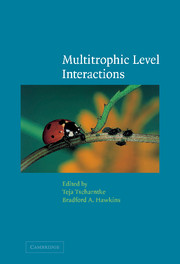Book contents
- Frontmatter
- Contents
- List of contributors
- 1 Multitrophic level interactions: an introduction
- 2 Plant genetic variation in tritrophic interactions
- 3 Multitrophic/multispecies mutualistic interactions: the role of non-mutualists in shaping and mediating mutualisms
- 4 Tritrophic interactions in tropical versus temperate communities
- 5 Endophytic fungi and interactions among host plants, herbivores, and natural enemies
- 6 Multitrophic interactions in space: metacommunity dynamics in fragmented landscapes
- 7 The chemical ecology of plant–caterpillar–parasitoid interactions
- 8 Canopy architecture and multitrophic interactions
- 9 Tritrophic below- and above-ground interactions in succession
- 10 Multitrophic interactions in decomposer food-webs
- Index
2 - Plant genetic variation in tritrophic interactions
Published online by Cambridge University Press: 08 August 2009
- Frontmatter
- Contents
- List of contributors
- 1 Multitrophic level interactions: an introduction
- 2 Plant genetic variation in tritrophic interactions
- 3 Multitrophic/multispecies mutualistic interactions: the role of non-mutualists in shaping and mediating mutualisms
- 4 Tritrophic interactions in tropical versus temperate communities
- 5 Endophytic fungi and interactions among host plants, herbivores, and natural enemies
- 6 Multitrophic interactions in space: metacommunity dynamics in fragmented landscapes
- 7 The chemical ecology of plant–caterpillar–parasitoid interactions
- 8 Canopy architecture and multitrophic interactions
- 9 Tritrophic below- and above-ground interactions in succession
- 10 Multitrophic interactions in decomposer food-webs
- Index
Summary
Introduction
The host plants of herbivores are not neutral substrates upon which interesting herbivores–natural enemies occur. Both the dynamics as well as the outcome of particular herbivore–natural enemy interactions may vary with the herbivore's host plant species, or genotype within species, and understanding such variation is central to the study of tritrophic interactions. The theory of tritrophic interactions implies that plant characteristics that enhance the success of the natural enemies have evolved; plants with traits that encourage the success of natural enemies should have a selective advantage over plants that do not, thus the trait should spread through the plant population (Price et al., 1980; Fritz, 1992, 1995; Hare, 1992). The primary genetic question underlying this chapter is whether the impact of natural enemies on herbivores is sufficiently strong and systematic to cause changes in gene frequencies in plant traits affecting the impact of natural enemies on those herbivores.
In this chapter, I will provide a brief review of several studies showing how genetic variation in plants may affect the outcomes of herbivore–natural enemy interactions. Most of these studies originated from applied studies in biological control. The strengths and weaknesses of those data in developing a general expectation of tritrophic interactions will be evaluated. I will conclude with a list of specific research objectives that may facilitate the development of a more predictive theory of tritrophic interactions.
- Type
- Chapter
- Information
- Multitrophic Level Interactions , pp. 8 - 43Publisher: Cambridge University PressPrint publication year: 2002
- 58
- Cited by

